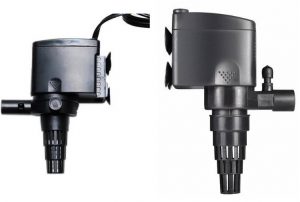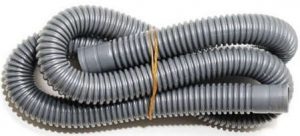
View On Amazon
| Size | Dimensions | Tank Size | Noise Level | Longevity | Price |
| 158 GPH | 3.54″ x 1.89″ x 5.11″ | 16-28 Gallons | Medium-Low | 6 Months-1 Year | Very-Low |
| 422 GPH | 5.15″ x 2.68″ x 6.3″ | 28-50 Gallons | Medium-Low | 6 Months-1 Year | Very-Low |
The Sunsun JP Super Aqua powerhead is a budget powerhead that does exactly what it says. With both 158 and 422GPH sizes it can easily meet many aquarists water flow needs without breaking the bank. It has a few extra uses, such as being a water pump, filter or air injector. Over all the Sunsun Super Aqua brings a lot to the table at a low price.
Set-up
Before setting the powerhead up you will need to take not of the body and positions of the intake and output. First off the body is fairly bulky with the intake also taking up a fair amount of space. This can detract from the natural appearance of the tank. Be sure to submerse the powerhead in water, as it will not work when only partially submerged.
The Powerhead comes with a short power cord, measuring at about 4 feet, meaning you will need the tank right next to its power source. This isn’t too difficult when using a power strip but is still something to take note of.
Like most powerheads the Sunsun JP Super Aqua only turns on and off when it receives or loses power. If you need to shut it off often you will want to either put the cord in an easy to reach location or be willing to shut off the power strip entirely. Additionally you can hook it up to a timer and have that control when the powerhead comes on and off. Rather than use a high tech aquarium light timer I simply have my light and powerhead attached to a garden light timer, shutting them off and turning them on at specific times of the day. Simple and cost effective.
Next you will need to decide if you are using the air injector feature. This uses the included airline tubing to aerate the water via a constant stream of bubbles. This is an excellent solution when you do not want to have an air pump and will not be pointing your powerhead towards the surface. Essentially this maximizes your horizontal water flow while removing another piece of machinery. The only downside is it makes a bit more noise thanks to the bubbles. You can turn the air knob to lower the amount of bubbles made, but it will still be fairly high even on the lowest setting.
Air pump + Air Stone + electricity or attach the air line tubing to this powerhead and take all those costs out of the equation. Pretty easy choice in my opinion.
Important Note: If you are going to use the air injector please also use the clear h clip that is included with the powerhead. This is used to hold the other end of the airline tube above the waters surface. Doing so prevents reverse siphons when the power fails, which would normally result in a lot of water being drained out of the tank.
Many aquarists will use this as a water pump. This can be for sumps, refugiums, water changes or whatever else you need to move water for. Again the powerhead comes with the needed tubing, making set up a simple process. Simply pull the tubing into place, ensuing it fits snuggly, and place the end of the tube wherever you need it to go. The tube is very flexible, and somewhat thin. While this does make it light weight it is also fragile, so avoid tearing it with sharp objects or rough corners (DIY cut glass tops are a common one).

The final use for the Sunsun Super Aqua is as a sponge/under gravel filter. Personally I would never recommend an under gravel filter, but placing a sponge filter around the intake is fairly straight forward and easy to clean. It isn’t a full blown filtration system, but doing this will certainly keep the water more clear.
Attaching the powerhead
This deserves its own mini section. The powerhead is fairly bulky, with the suction cup attachments often failing to hold the powerhead into place. To counter this you can heat the suction cups just before attaching them to the glass. Quickly submerge and attach them to the glass. As they cool, the air underneath the suction cups will condense, forming a much stronger bond between the suction cup and glass. This will hold the powerhead in place much better, but also make it more difficult to remove.
Tank Size & Fish Safety
Unlike most powerheads, this model features a small, tube shaped opening. This allows it to be used as a water pump, but also focuses all the flow into a much smaller area. In this sense you should imagine the flow as water shooting from a hose rather than the traditional jet shaped output. This will prevent any fish from being harmed, as the propeller is deep in the powerhead with the output as the only open entry way.
Because the output is very focused the powerhead should be used lower in the tank and to one side. This will encourage better water circulation, giving you the best flow in your tank.
When using the smaller JP-022 model your tank should be between 8 and 30 gallons, while the larger JP-025 will be used for tanks between 20 and 50 gallons. Be sure not to provide too much or too little flow for your fish. Read into what they need, and if you do have too much flow you can arrange the tank decoration/rock structure to diffuse the water flow. Additionally you can aim the powerhead at the wall of the tank, which will weaken the water flow.
The powerhead does not have the “running in reverse” issue that most powerheads have. This is likely because it is also made to be a water pump, making the design team work harder on keeping the propeller running the right way.
Assembly
When taking the powerhead apart, which is mostly done for cleaning, you will want to only remove the impeller cover. This is the portion that the output tube is attached to. You can then clean out the inside of the powerhead, impeller and all. If the powerhead builds up too much waste on the insides it can lose some of its power and increase the stress on the components, which in turn leads to a shortened life span. Clean at least once a month to prevent this.
Additionally you can remove the back cover and clean out that portion too. This is more to reduce heat generation than anything else and is not as important as cleaning the front. Still it may improve the powerheads lifespan and only takes a few seconds.
Flow & Adjustments
Both the direction and flow rate of the Sunsun Super Aqua cannot be adjusted, making this a real plug and play powerhead. If you do wish to reduce the power you will need to diffuse the water strength by obstructing the water flow or partially covering the outlet.
As previously stated you can adjust the flow rate of the bubbles, but the two settings are high and very high. This can be adjusted using an inline air control valve, which can be found at any store for about $1.
The flow rate labeled and the flow rate received are identical, meaning you do not have to buy more than you need. If you are only going to be using the pump for water changed, I highly recommend the 158 GPH model, as it is still 2.6 gallons a minute. Even a 100 gallon water change would only take 38 minutes. The price difference is only a few dollars though, so this is entirely up to preference.
Warranty & Lifetime
Being a Sunsun product means there is no real warranty on the powerhead. Instead you will need to rely on amazons 30 day warranty to find all defects in the powerhead. Be sure to go over your powerhead thoroughly on the last few days!
Once the warranty period has ended you can expect 6 months to a year of service before this powerhead gives out. This is a short lifetime for a powerhead no doubt, but for water changes, salt mixing and other various needs the powerhead will last much longer. Likewise if you only have the powerhead run in the day time it can live longer.
Overall the Sunsun JP Super Aqua powerhead is a low cost, effective powerhead that has a multitude of uses. If you are just getting into the aquarium hobby it’s a solid choice as you will get a quality experience for a low price.